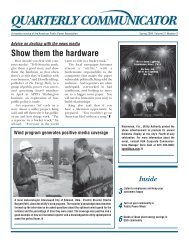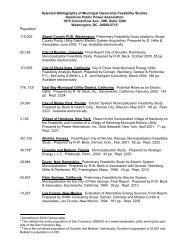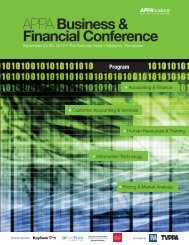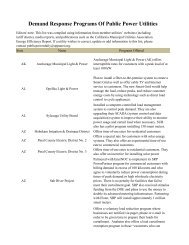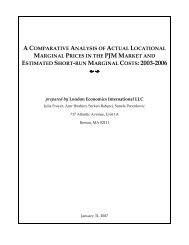Current DEED projects - American Public Power Association
Current DEED projects - American Public Power Association
Current DEED projects - American Public Power Association
Create successful ePaper yourself
Turn your PDF publications into a flip-book with our unique Google optimized e-Paper software.
IntroductionThis flyer provides a summary of <strong>DEED</strong> funded grants and scholarships that are currently inprogress. Grants are listed first, followed by scholarships, which are sub-categorized into thefollowing topic areas:Table of ContentsGrantsScholarshipsn Careers in <strong>Public</strong> <strong>Power</strong> 3 15n Distribution (Storage, Microgrid, Demand Side 4 15Management, Electric Vehicles, Lighting, etc.)n Electric Utility Primers 8n Energy Efficiency and Environmental 9 18n Generation, Transmission and <strong>Power</strong> Supply 11 20n Governance, Strategic Planning and Leadership 12n Reliability 12 23n Safety 13n Utility Finance and Accounting 14
<strong>DEED</strong> GrantsTo encourage and promote energy innovation, APPA’s Demonstration of Energy & EfficiencyDevelopments (<strong>DEED</strong>) program provides financial support to its members forthe development and demonstration of new, innovative technologies and techniques,and the creation of useful products and tools for the betterment of public power utilities andtheir customers. Grants can be used to improve utilities by increasing efficiency, reducing costs,investigating new technologies, offering new services and improving processes and practices tobetter serve customers.Careers in <strong>Public</strong> <strong>Power</strong>Colorado State Science &Engineering Fair 2014-17 (1055)Platte River <strong>Power</strong> Authority, ColoradoThe purpose of this $1,000 grant is to continue for an additionalfour years the <strong>DEED</strong> awards that were establishedat the 2012 and 2013 Colorado State Science and EngineeringFairs. These awards are for selected students inthe Senior and Junior Divisions which are judged by PlatteRiver and its four constituent municipalities. The awardsare made on behalf of the <strong>American</strong> <strong>Public</strong> <strong>Power</strong> <strong>Association</strong>’s<strong>DEED</strong> Program. The awards recognize achievementin the areas of Energy Efficiency and Innovation, and EnvironmentalInnovation, and will be awarded to selectedstudents as follows: <strong>DEED</strong> Energy & Efficiency InnovationAward: Senior Division 1@$75, Junior Division 1@$50;and <strong>DEED</strong> Environmental Innovation Award: SeniorDivision 1@$75, Junior Division 1@$50. The awards willexpose hundreds of innovative and capable students to<strong>DEED</strong> and public power. This exposure can be replicatedin states where science and engineering fairs are held.The primary benefit of continuing sponsorship of the<strong>DEED</strong> awards at the Colorado State Science and EngineeringFair is that <strong>DEED</strong> will continue to receive positiveexposure, year after year for a modest investment. Targetcompletion date: 04/30/2017. Work Force Development >Student Programs > Science Fair AwardsDevelopment of a <strong>Power</strong> SystemEducational Program (1052)Memphis Light, Gas & Water, TennesseeMemphis Light, Gas & Water was awarded a $52,303grant to develop a power system educational programto provide on-the-job training for existing engineers atMemphis Light, Gas and Water, other utilities or powerindustries, and potential engineering students from universitiesor colleges to study power systems. The projectproposes to develop a power system educational programwhich can be accessed by anybody. In addition to requiredfinal report and abstract, other deliverables of this projectinclude: a detailed power system educational programwith syllabus and course materials to be provided on aneducational CD; technical reports that will cover the contentsof the CD and other associated reports; and publishingthe outcomes of this research in journals and conferencesas the project progresses. Target completion date:12/31/2014. Training > <strong>Power</strong> System Engineering
4 <strong>DEED</strong> <strong>Current</strong> ProjectsDistribution (Storage, Microgrid, Demand Side Management,Electric Vehicles, Lighting, etc.)Distribution System Performance ImprovementGuide (1034)<strong>DEED</strong> Board/<strong>American</strong> <strong>Public</strong> <strong>Power</strong> <strong>Association</strong>,Washington, D.C.An update of APPA’s 1997 publication “DistributionSystem Performance Improvement Guide” will be fundedby a $28,000 grant from <strong>DEED</strong>. Distribution system performanceimprovement is a major factor in maintaininga competitive posture in an increasingly competitive industry.Cost, reliability and quality of service are impactedsignificantly by distribution system losses. In the 15 yearssince the guide’s publication, numerous rules relating todistribution system equipment, including distributiontransformer efficiency standards, have been revised by theDepartment of Energy and municipal utilities are continuouslyexposed to business risks that are outside their control.The updated manual will give public power utilitiescurrent tools and guidelines for making informed decisionson this topic. Target completion date: 09/30/2014.Utility Operations > Distribution > EfficiencyDSTAR Program 14 (1027)<strong>DEED</strong> Board/<strong>American</strong> <strong>Public</strong> <strong>Power</strong> <strong>Association</strong>,Washington, D.C.$90,000 in funding continues <strong>DEED</strong>’s participation inthe DSTAR consortium. DSTAR (Distribution SystemsTesting Applications and Research) is an industry coalitionthat jointly supports research on near-term, practicalimprovements for electric distribution systems. <strong>DEED</strong>joined the group in 2010. <strong>DEED</strong> participation in DSTARgives all APPA members access to DSTAR research findings.Information is accessible on the <strong>DEED</strong> website www.publicpower.org/<strong>DEED</strong>; choose the DSTAR tab from thetop bar. $2,500 in travel funds were approved to enable a<strong>DEED</strong> representative to participate in DSTAR meetings.Program 14 <strong>projects</strong> include:n Project 14-1 thru 14-3: Administrative Projects,Software Maintenance & Marketing Campaign.n Project 14-4: Surge Protection of Electronically-Controlled Devices Installed in Distribution Systems.n Project 14-5: Cable Pulling Assistant SoftwareEnhancement.n Project 14-6: Best Practices for Integration of UtilityCommunications.n Project 14-7: Survey of Best Practices forCopper Theft Deterrence.n Project 14-8: Motor Problems Resolution andAvoidance – CRN <strong>Public</strong>ation Update.n Project 14-9: Best Practices to Improve Reliabilityn Project 14-10: Cable Ampacity CalculatorTarget completion date: 05/31/2015. Utility Operations> Distribution > Efficiency/Reliability/<strong>Power</strong> Quality/Equipment Applications/Economic AnalysisDSTAR—Program 13 (852)<strong>DEED</strong> Board/<strong>American</strong> <strong>Public</strong> <strong>Power</strong> <strong>Association</strong>,Washington, D.C.A grant for $90,000 was committed for <strong>DEED</strong> to joinDSTAR. DSTAR is a consortium of electric distributionutilities and utility organizations that collaboratively sponsornear-term, pragmatic distribution R&D that can beapplied readily to everyday system design, operation andmaintenance activities. Research activities are conceivedand directed by the member utilities. GE Energy managesthe DSTAR collaborative.Program 13 research <strong>projects</strong> are posted on the <strong>DEED</strong>website www.<strong>Public</strong><strong>Power</strong>.org/<strong>DEED</strong> in the DSTAR area.APPA members must login to access the following research<strong>projects</strong>:n Project 13-1: Administrative & Computer Updatesn Project 13-2: Commercial Load Estimation Program–Completen Project 13-3: Inspection and Maintenance Survey–Completen Project 13-4: Secondary Electrical Design Software(SEDS) Enhancements–Complete
<strong>American</strong> <strong>Public</strong> <strong>Power</strong> <strong>Association</strong> 5n Project 13-5: Harmonic Load Impact and Mitigation–Completen Project 13-6: Centralized vs. Distributed FeederAutomation–Completen Project 13-7: Conservation Voltage Reduction (CVR):Testing, Methods, and Results–Completen Project 13-8: SEDS-Based Lighting Tool–Completen Project 13-9: PV Impact on Distribution Systems—Completen Project 13-10: Smart Grid Impact on DistributionReliability—CompleteCompleted: 03/31/2014. Utility Operations > Distribution> Efficiency/Reliability/<strong>Power</strong> Quality/EquipmentApplications/Economic AnalysisThe Potential Effects of Increasing Use of SolidState Lighting with Lighting Controls (1044)Silicon Valley <strong>Power</strong>, Santa Clara, CaliforniaSVP will study power system impacts of a high penetration-levelof dimmers, driven by the projected growth ofsolid-state lighting. Three aspects will be evaluated: meteringand billing, harmonic effects on power quality, andimpacts on power system stability. Measurements made onrepresentative hardware in the laboratory will be analyzedand used to identify opportunities to improve the qualityof circuit models used for system studies. Target completiondate: 06/30/2014. Utility Operations > Lighting >Metering & Billing; <strong>Power</strong> Quality/<strong>Power</strong> System StabilityActive Reactor Field Test Trial (702)Jackson Energy Authority, TennesseeJackson Energy Authority received a $22,000 grant forthis project to field-test a new technology, Active Reactor,for energy-efficient street lighting applications in an existingroadway lighting location. With the Active Reactor, ahigh-intensity discharge lamp will run at constant lightthroughout its life, modifying the power as the lamp ages.This trial will verify the manufacturer’s claims that theActive Reactor can deliver power and energy savings of20–25 percent and extend lamp life by over 50 percentwhen applied to high-pressure sodium (HPS) lamps.Target completion date: 12/31/2014. Utility Operations >Distribution > LightingCloud<strong>Power</strong> Residential Energy StorageDemonstration (1031)Holyoke Gas & Electric, MassachusettsA grant of $125,000 was awarded to Holyoke Gas &Electric, which has partnered with Sparkplug <strong>Power</strong> andMavizeus Inc. The grant is funding a demonstration of 25centrally controlled Cloud<strong>Power</strong> residential distributedenergy storage system (DESS) units at various customerlocations on the Holyoke Gas & Electric electric grid.Residential DESS enables a utility to defer infrastructureupgrades and reduce transmission and capacity coststhrough peak load shaving, while simultaneously providingoutage protection for residential customers and transparencyin demand-side management. The goal of thisproject is to quantify cost savings attributable to DESS,identify the primary barriers associated with commercialimplementation of DESS, and collect data to facilitatestudies that assist in minimizing those barriers. Targetcompletion date: 8/31/2014. Customer > Demand SideManagement > Energy StorageMissouri S&T Microgrid DemonstrationEmploying Renewable Energy and AlternativeFuel Sources (1040)City Utilities of Springfield, MissouriA $125,000 <strong>DEED</strong> grant will support the continued workon a community energy storage project by City Utilitiesof Springfield and the Missouri University of Scienceand Technology’s Solar Village (<strong>DEED</strong> grant 1003). Theproject brought together residential renewable distributedgeneration and real-time state-of-the-art energy storage ina community-focused atmosphere. That project employedthe ability to share energy across boundaries throughcombined storage technology and took advantage of thedynamic peak-shaving capabilities within even a smallcommunity. The Missouri S&T microgrid demonstrationwill take the community energy storage project furtherwith the integration of alternative fuel generation andwaste heat recovery for domestic water heating, spaceheating and electric vehicle charging. Target completiondate: 12/31/2014. Customer > Distributed Generation >Microgrid/Solar/Storage
6 <strong>DEED</strong> <strong>Current</strong> ProjectsDemonstration of Community Energy StorageIncorporating Renewable Resources (1003)City Utilities of Springfield, MissouriThis project will develop the concept of small-scale energymanagement using lithium-ion battery technology. Thegoal is to show the public the benefits of implementing acommunity energy storage system. In this project, a groupof residences with renewable resources will be managedto benefit the community. This project is expected tohighlight the use and effectiveness of energy storage as amedium for community-wide energy management.The feasibility of this technology will be at the forefrontof this project’s output. The feasibility includes: theevaluation of the costs (procurement, installation andmaintenance), the inherent benefits to the electric utility,economic benefits on both the utility and consumer side,and evaluation of peak power manipulation. City Utilitieswill establish design guidelines and standards to sizeand maintain the community energy storage systems.The Missouri S&T Solar Village site will host the systemto showcase the development for communities interestedin creating a community energy plan. A $75,000 <strong>DEED</strong>grant is supporting this project. Target completion date:05/31/2014. Customer > Distributed Generation > Solar/PV/Battery StorageIntegrated Vehicle Energy Storageand Solar Project (1007)North Carolina State UniversityNC State will design, build and operate a solar-poweredelectric vehicle charging station coupled with an energystorage system. The integrated Vehicle Energy Storage &Solar Demonstration (VESSD) system will be installed atthe Keystone Science Center at NC State University andwill be connected to the microgrid in an adjacent smartgrid lab. A large LED monitor will be mounted on theparking structure to monitor energy generation and flowbetween components in real time and provide an educationalvisual display for visitors. The system will integrateseveral advanced energy technologies and serve as a testbed for intelligent integration of renewable generationand storage within microgrids. The VESSD system willprovide a valuable tool for enhancing ongoing energyresearch, education, and deployment of electric vehicles.Research findings are expected to inform EV station deploymentacross the United States.The effective management of distributed renewablegenerating assets, EVs and energy storage is valuable toutilities. As the number of EV charging stations grows,utilities will need to understand and manage their use tooptimize efficiency and obtain operational benefits forthe electricity grid. The data gathered and best practicesidentified in this project will be valuable to APPA members.Upon completion of the project, the university mayhost an APPA meeting to showcase the system and the additionaladvanced electrical systems under development atthe university’s research centers for renewable energy andadvanced transportation technologies.The system may be replicated by APPA member utilities.The specifications and electrical design of the systemcan be tailored and scaled appropriately for any numberof EVs, PV system size, and energy storage capacity. A$48,000 <strong>DEED</strong> grant is supporting this project. Targetcompletion date: 04/30/2014. Customer > Demand SideManagement > Storage > Electric Vehicles/RenewableEnergy/MicrogridField Measurement of Plug-in Electric Vehicle(PEV) Grid Impacts (868)Sacramento Municipal Utility District, (SMUD),CaliforniaSMUD will design and conduct experiments aimed atimproving understanding of the grid impacts of PEVcharging. A PEV charger/battery load simulator will be designedand assembled to replicate actual vehicles expectedto enter the market. Expected PEV/distribution scenarioswill be surveyed, including charging concurrently withnominal demand, off-peak charging, and cluster charging,where multiple PEVs charge on the same distributionfeeder/transformer. Particular attention will be given totransformer loading and therm cycling, voltage sag/flicker,and power quality effects of PEV charging. Testing systemresponse now to a variety of demands from PEV chargingwill enable better planning and timely execution ofupgrades that may become necessary to maintain systemreliability. SMUD received a $75,000 <strong>DEED</strong> grant forthis project. Target completion date: 09/30/2014. UtilityOperations > Grid Impact/Reliability/<strong>Power</strong> Quality >Electric Vehicle Charging
<strong>American</strong> <strong>Public</strong> <strong>Power</strong> <strong>Association</strong> 7Destination Station—An Electric Vehicle Charging Station (1005)Kennebunk Light & <strong>Power</strong> District, MaineWhile some areas of the country (such as California andTexas) have plans in place for establishing “green highways”of electric vehicle charging infrastructure, manyareas of the country are similar to Maine and lack thenecessary infrastructure. This project will demonstrate theease and usefulness of installing a Level 2 EV chargingstation. The project webpage will include contact informationto allow other public power utilities to learn from theKennebunk project. The utility hopes to provide the firstin a long “highway” of charging stations up the coast ofMaine. Success in Kennebunk could lead to installation ofmore stations in Portland, mid-coast (Boothbay Harbor/Camden), Belfast, down east Maine and Bar Harbor—alleconomically important to the state of Maine.Signage will direct drivers to the charging stationlocation and identify project sponsors including <strong>DEED</strong>,KLPD, the Town and the Kennebunk Energy EfficiencyCommittee. Kennebunk Light & <strong>Power</strong> will track usageof the electric vehicle charging station by monitoring thenumber of cars that use the station, and recording homezip codes of people using the station. The scope of thisproject was increased to include PV lighting in the chargingarea. A $7,635 <strong>DEED</strong> grant is supporting this effort.Target completion date: 05/31/2014. Customer > <strong>Public</strong>Benefit Program > Solar/PV/Electric VehiclesResidential Thermal Energy Storage Systems (1045)Azusa Light & Water, CaliforniaAzusa Light & Water was awarded a $60,000 grant to pursuethe demonstration of small-scale thermal energy storage(TES) systems prototype designed by Ice Energy LLCthat works in conjunction with existing refrigerant-baseddirect expansion air conditioners to shift peak demand tooff-peak periods. It is expected that this technology canreduce and shift 90-95% of the AC unit peak demand requirements.The successful demonstration and evaluationof these TES systems will provide the impetus necessaryfor the commercialization of the residential TES systemsfor the benefit of all APPA Members. The fully-dispatchablethermal energy storage Ice Bear technology and itsassociated peak shifting offers significant potential valueto APPA members and all utilities that: experience peakload conditions due to AC load; suffer from load/resourceimbalances; experience minimum load conditions; havedistribution system substations, circuits and/or feedersthat are overloaded and impair service reliability duringcritical peak operating periods; and/or are workingto assimilate intermittent renewable resources into theirresource portfolio. Target completion date: 12/31/2014.Utility Operations > Distribution > Efficiency/DemandSide Management > Load ManagementComparing Customer Engagement Success acrossMultiple Smart Grid Technology Platforms (1058)Wadsworth Electric and Communications, OhioThe City of Wadsworth proposes systematic tests of a setof messages and incentives designed to drive customersto interact with energy management tools on a repeatedbasis. The goals of this $65,000 grant are to: acquire atleast 3,250 new sign-ups for Wadsworth’s single sign-onweb portal; cultivate an “energy management culture”in which at least 10% of Wadsworth households interactwith energy management tools on a monthly basis; andcreate a self-sustaining revolving door fund with which topurchase incentives that have a positive effect on customeracquisition and retention. Deliverables, other than thosethat are required, will include: a list of most effectivemessages and rewards; summary of statistics; a 10-pagefinancial administration manual for implementing andmaintaining a revolving door fund; a 5 page businessmarketing manual for small utilities; web-based ROIcalculator available to all APPA members; an 8-page datasecurity and format recommendations; and a presentationat an APPA conference presentation. Target completiondate: 10/31/2014. Customer > Demand Side Management> Load ManagementConsumer Preferences for AlternativeElectric Service Plans (1057)Tennessee Valley AuthorityThe purpose of this $124,000 <strong>DEED</strong> grant is to demonstrateand provide APPA with a tested valuable and powerfulmarket research method, called discrete choice experiments(also known as conjoint analysis), so that its publicpower members can discover consumer preferences fornew service plans and construct market segments prior to
8 <strong>DEED</strong> <strong>Current</strong> Projectsmajor capital investments. New metering, communication,and control technologies create possibilities for utilitiesto offer residential customers new functionally diversifiedservices that closely match terms of service with supplycosts. Characterizing and quantifying electric service preferenceswill help utilities calculate the benefits they canexpect from investments in smart meters and associatedtechnology, and from implementing behavioral changeprograms like dynamic pricing and household electricitymanagement devices and systems. The project will demonstrateresearch methods that APPA member utilities canuse to determine how to diversify their residential retailelectric services. Knowing how to match service needsprior to a major program launch can increase customersatisfaction, improve subscription, improve a utility’s operationalefficiency, and enhance the performance of theelectric system APPA members manage. TVA is partneringwith TVPPA and EPRI for this project. Target completiondate: 8/31/2014. Customer > Demand Side Management> Energy Efficiency/Load ManagementElectric Utility PrimersCustomer Engagement Guidebook—Smart Grid Essentials (1062)<strong>DEED</strong> Board/<strong>American</strong> <strong>Public</strong> <strong>Power</strong> <strong>Association</strong>,Washington, D.C.Many small and medium sized utilities are transitioningto smart/advanced grid technologies in order to betterserve their customers. These utilities are sometimes,unfairly, receiving backlash by customers due to misinformation.The purpose of this guidebook is to provide utilitystaff, mayors, city council members, and other communitychampions with accurate information and resourcesabout electronic equipment, including smart meters, inorder to properly educate their constituents and avoidthis backlash.A $35,000 grant will support development of thispublication which will be the third in a series of SmartGrid Essentials guidebooks developed by APPA with supportfrom <strong>DEED</strong> since 2009. The guidebook will serve asa primer for customer engagement as it relates to smart/advanced grid technologies. Chapters would focus on, butnot be limited to: defining the new normal in customerengagement, customer concerns about smart meters,benefits of smart meters, developing policies, plans andprocedures, community partnerships, case studies of municipalutilities, use of social media and other technologiesfor engagement, measurement and verification of theefficacy of engagement plans, vision for 10 years out, andan appendix.The guidebook will be useful to utilities at any stageof their smart grid development. By providing case studyexamples, “do’s and don’ts,” and templates for designingcustomer engagement programs, this guide will havebroad applicability to all public power utilities. Targetcompletion date: 10/31/2014. Customer > Smart Grid >Customer Engagement/<strong>Public</strong> ParticipationSolar Engagement Options for <strong>Public</strong> <strong>Power</strong> (1061)<strong>DEED</strong> Board/<strong>American</strong> <strong>Public</strong> <strong>Power</strong> <strong>Association</strong>,Washington, D.C.The use of solar energy is growing as an electric generationtechnology, with strong support among <strong>American</strong>consumers. With distributed generation on the rise, manyutilities are driven to consider solar options or potentiallyface the loss of customers to alternative energy providers.A $20,250 grant will support the work of the SolarElectric <strong>Power</strong> <strong>Association</strong> (SEPA) to research and writea publication to provide public power utilities with ahigh level strategic overview of their utility business solarengagement options with ten or more detailed case studieson specific public power utilities. SEPA will presentinformation from a municipal perspective using municipalcase studies and research from which public power utilitiescan use the report as a reference to begin exploring thesolar opportunities that meet their specific business needs.This report will educate public power utilities abouttheir solar opportunities by presenting options to expandservice offerings and offer customer-friendly solar options—rangingfrom simple initiatives to resource intensivecustomer programs. The publication will utilize publicpower utility case studies to reinforce solar options/opportunities.Target completion date: 10/31/2014. Generation> and Customer> Distributed Generation > Solar
<strong>American</strong> <strong>Public</strong> <strong>Power</strong> <strong>Association</strong> 9APPA’s Pole Attachment Workbook (G-309)<strong>DEED</strong> Board/<strong>American</strong> <strong>Public</strong> <strong>Power</strong> <strong>Association</strong>,Washington, D.C.This workbook was last revised a decade ago and hencedoes not reflect changes in Federal CommunicationsCommission and state regulations related to pole attachmentpolicies. APPA staff worked with communicationsattorneys Jim Baller and Sean Stokes to updatethe book. The FCC revised its pole attachment rules in2011. $10,000 has been committed to update this workbook,which is a vital source of information for publicpower utilities when they are renegotiating pole attachmentagreements. Completed: 03/2014.Energy Efficiency and Environmental2013 SmartStructure LiteCollaborative Pilot (1028)Omaha <strong>Public</strong> <strong>Power</strong> District, NebraskaOmaha <strong>Public</strong> <strong>Power</strong> District was awarded a $117,768<strong>DEED</strong> grant to pilot and evaluate a newly developedbuilding management system, SmartStructure Lite. Ithas several proven systems combined to produce maximumenergy savings at an affordable cost for small tomid-size businesses. This project involves multiple <strong>DEED</strong>members. Participating utilities will get hands-on experiencewith the technology and will validate cost, ease ofinstallation, and use. The team, with OPPD acting asfacilitator, will also assess energy efficiency, demand reductionand demand response capabilities. Target completiondate: 12/31/2014. Customer > Demand Side Management> Energy Efficiency & Energy Management SystemsEnergy-efficient Air Filtration witha Novel Plasma Precipitator (1056)Seattle City Light, WashingtonSeattle City Light was awarded $50,000 to develop a newtype of energy-efficient air filtration system that has highcleaning efficiency, low energy consumption, and can beoperated for long periods of time without performancedegradation, and, in many cases, eliminates the need formesh filters. Such a system would save very large amountsof energy while improving the quality of air in commercial,industrial, and medical facilities. The new technologyis free from sparks and arcs and is fireproof and allowsfor a dramatic decrease in maintenance costs, due to theincreased time between filter media replacement. Overallbenefits to utilities and manufacturers include: energysavings; reduction of ozone footprint; high scalability; lowmaintenance and filter costs; and having a spark/fire prooffilter. Target completion date: 09/30/2014. Customer >Energy Efficiency > HVACThe E-Tracker Project: Tracking Daily ElectricEnergy Use and Weather Data (1043)ElectriCities of North Carolina, Inc.ElectriCities will develop an energy education programthat centers on daily electric energy use and weathertracking. The project’s goal is to educate high school studentsabout the relationship between electric energy useand temperature and the impact of appliances on electricuse. The program will incorporate scientific methods andrequire students to apply linear regression to determinethe strength of these relationships, as well as test otherhypotheses that affect electricity use. The $21,000 grantwill also support a public relations campaign to ensuremedia coverage, and the project will be documented witha video for presentation on ElectriCities, APPA, and otherwebsites. Target completion date: 04/30/2014. Customer> Energy Efficiency > Schools
10 <strong>DEED</strong> <strong>Current</strong> ProjectsThe Energy Edutainment Experience (1026)Lincoln Electric System, NebraskaA $2,500 <strong>DEED</strong> grant was awarded to support LES’sproject to develop an “energy edutainment experience.”The project aims to convey energy information in anentertaining manner. It draws on the education/entertainmentpractices of Walt Disney and the “Cone of Experience”model developed in 1946 by Edgar Dale, a professorat Ohio State University. Dale’s model demonstratedthat people retain more information when material ispresented in an entertaining manner. LES’s edutainmentexperience will include information on energy efficiency,reliability, generation options and other industry topics.Target completion date: 4/30/2014. Customer > EnergyEfficiency > EducationInteractive Tools and Training Materials toEnhance <strong>Public</strong> <strong>Power</strong>’s Ability to BenchmarkEnergy Efficiency Performance (1019)Santee Cooper, South CarolinaSantee Cooper is leading a consortium of six publicpower utilities in a project to develop interactive tools andtraining materials for benchmarking energy efficiencyperformance. Other utilities participating in the energyefficiencybenchmarking project include Austin Utilitiesin Texas, Nebraska <strong>Public</strong> <strong>Power</strong> District, Omaha <strong>Public</strong><strong>Power</strong> District in Nebraska, Orlando Utilities Commissionin Florida, and Tacoma <strong>Power</strong> in Washington. A $75,000<strong>DEED</strong> grant supports this project.The utilities will work with the Alliance to Save Energy’sClean and Efficient Energy Program for <strong>Public</strong> <strong>Power</strong>(CEEP) to develop a user-friendly online tool that willgenerate peer comparison charts for indicators such asenergy savings, demand reduction potential, and energyefficiency spending relative to utility size. CEEP will useenergy efficiency and demand response data submitted bymunicipal and other electric utilities on the U.S. EnergyInformation Administration Form 861. <strong>Current</strong>ly, datasubmitted on form 861 is not available to utilities in auser-friendly way. The <strong>DEED</strong> project aims to make thatdata more meaningful and useful. Small utilities that donot submit efficiency data to EIA will be able to use thetool to submit data. Target completion date: 06/30/2014.Customer > Energy Efficiency > Evaluation & VerificationHealthy Energy Sustainable Home BuildingPractices (1006)Nebraska <strong>Public</strong> <strong>Power</strong> DistrictThis project will document the design and construction ofa high-efficiency home, built exclusively around currentbuilding science best practices. The home will be usedto educate several key market groups. Illustrating theconstruction techniques from the beginning of the projectto the end will address persistent concerns among theconstruction trades that these techniques will not work orare too labor-intensive. Another goal is to shift customerbuying priorities from a heavy focus on the aesthetics ofthe home to one based on health, comfort, durability andthe positive impact on long-term disposable income.Key components of the construction process will befilmed and documented and then edited into an educationalvideo with an instructional flyer and educationalguide for target audiences. Affordable, proven technologiesexist for dramatically increasing the efficiency ofexisting buildings, yet building owners are investingrelatively little in these technologies. Potential benefits ofthese building practices include affordable housing, lowerenergy costs, improved health, reduction of greenhousegases and reduced reliance on foreign energy supplies. A$12,500 <strong>DEED</strong> grant is supporting this effort. Target completiondate: 05/31/2014. Customer > Energy Efficiency> Energy Conservation > Residential BuildingsThe True Green House (834)Piedmont Municipal <strong>Power</strong> Agencyand City of Clinton, South CarolinaThis project will serve as a comprehensive case study onrenovating older homes to improve energy efficiency.PMPA and Clinton will create a system to provide all thetools and resources necessary to help a homeowner makea wise financial and environmental decision. These toolswill be made available to all <strong>DEED</strong> members to share withtheir customers after completion of the project. Four studentsfrom Presbyterian College will assist in this project.A $40,000 grant is supporting this effort. Target completiondate: 05/31/2014. Customer > Energy Efficiency >Energy Conservation > Residential Building Retrofit
<strong>American</strong> <strong>Public</strong> <strong>Power</strong> <strong>Association</strong> 11Generation, Transmission and <strong>Power</strong> SupplyBiopower Project Assessment and Decision MakingBest Practices Guide (1029)Florida Municipal Electric <strong>Association</strong>This project, supported by a $48,000 <strong>DEED</strong> grant, willinvolve biopower stakeholders in developing, endorsing,and distributing a consumer-friendly guide and videothat public power utilities and other community leaderscan use to build public support for sustainable biopower<strong>projects</strong>. The guide will provide tools for communities toidentify issues and options and reach a fact-based decision.The video will inform communities about diversestakeholder perspectives and encourage the guide’suse. Emotional public opposition, fueled by inaccurateinformation, has a history of stalling or closing biopower<strong>projects</strong>, costing utilities valuable opportunities to supplybaseload energy with affordable, environmentally friendly,fuel-mix-diversifying, local-job-creating biopower. Theguide and video will be useful tools for utilities consideringbiopower. Target completion date: 05/31/2014. UtilityOperations > Generation > BiomassEngineered Biomass Development:Phase II Trial Burn and Results (1046)City of Columbia Water and Light, MissouriThe City of Columbia Water and Light was awarded a$50,000 grant to support the trial burn of an engineeredbiomass fuel developed in Phase I (Spring 2012 <strong>DEED</strong>grant G-300), as well as further define and research theissues related to engineered biomass fuels for existingpower plant facilities. The project will encompass allfacets of the fuel supply necessary to verify and analyze:handling of engineered biomass fuel; boiler performanceand firing testing of engineered fuel; emission performancetesting; and collaboration to increase raw annuallyrenewable biomass supply. The comprehensive trial burnof the engineered fuel will identify all renewable characteristicsof the biomass fuel and provide a road map todemonstrate the feasibility of using this fuel to repower orco-fire using existing coal plants. In addition to the finalreport, webinar(s) will be delivered to <strong>DEED</strong> memberson the trail burn results, overview of biomass sustainablesupply chain and economic impact of the biomass project.Target completion date: 08/30/2014. Utility Operations >Generation > BiomassSpart Lowell Anaerobic Digester with CombinedHeat and <strong>Power</strong> and Green Machine (1013)Lowell Light and <strong>Power</strong>, MichiganLowell Light and <strong>Power</strong> will enter into a public privatepartnership to develop an 835-kW anaerobic digester. Thedigester will use a German technology known as an upflow/downflow/reflow(UDR) system. This will be the firstUDR system in the United States. Methane gas producedin the digester will be burned in an 800-kW combinedheat and power unit to create electricity. An organic rankinecycle device known as the “Green Machine” will beused to maximize the electricity generated at the project.The project is expected to serve as a template for otherelectric utilities considering a biogas project.The feedstock for the bio-digester will come from avariety of readily available renewable biomass sourcesthat are currently wasted, at significant cost. When usedlocally, the biomass has the potential to bring productioncost savings to local businesses. The project started as a400-kW facility and grew to 800-kW as feedstock contractsevolved. A $75,000 <strong>DEED</strong> grant is supporting this effort.Target completion date: 06/30/2015. Utility Operations >Generation > BiogasDemonstration of the Suitability of a Combination30-kW Concentrated Photovoltaic and SolarThermal Array System for Distributed GenerationUse (725)<strong>American</strong> Municipal <strong>Power</strong>, Inc., Columbus, Ohio<strong>DEED</strong> awarded a $45,000 grant to <strong>American</strong> Municipal<strong>Power</strong> Inc. to install PhotoVolt’s newly patented photovoltaicsystem at one of its member utilities. This concentratedPV technology has the capability to magnifythe energy of the sun 900 times and results in 1.5 kW ofsolar PV power per array (30 kW for the system) and anadditional 5 kW of thermal energy output per array (100kW for the system). The system will be monitored andmaintained to analyze its cost, performance and overallefficiency compared to traditional PV units. This will bePhotoVolt’s second demonstration of this new technology.Target completion date: 04/30/2014. Utility Operations >Generation > Solar
12 <strong>DEED</strong> <strong>Current</strong> ProjectsGovernance, Strategic Planning and LeadershipImpact of State Solar Policieson <strong>Public</strong> <strong>Power</strong> (1050)Iowa <strong>Association</strong> of Municipal UtilitiesThe Iowa <strong>Association</strong> of Municipal Utilities was awardeda $5,400 grant to collect, describe, rank, and summarizeinto “best practices” state laws and incentives governingthe development of solar photovoltaic <strong>projects</strong>. Thepurpose of this project is to provide public power utilitieswith better information to guide policy development onutility solar <strong>projects</strong> at a time when solar is an attractivecustomer-scale option that may have significant impactson utility services. <strong>Public</strong> power utilities could benefitsignificantly by developing their own community solar<strong>projects</strong> with the benefits ranging from purchasing powerand economies of scale for a larger-size project, the possibilityof greater community participation from customerswhere solar can’t be done, the possibility of bidding solarinto a capacity market, the benefits of utility maintenanceand optimization of the location, and the enhancementof the role of the utility as the solar power provider. Thedeliverables from this project, in addition to the <strong>DEED</strong> finalreport and summary abstract, would include a catalogof state laws and incentives, with web links to the rules,a ranking of laws and incentives that are more or lessfavorable to public power solar, and an analysis of the bestpractices available for public power. Target completiondate: 12/31/2014. Regulatory > Solar PV State PoliciesReliabilityeReliability Tracker Advancements (1036)<strong>DEED</strong> Board/<strong>American</strong> <strong>Public</strong> <strong>Power</strong> <strong>Association</strong>,Washingon, D.C.A second grant has been awarded to the APPA to buildupon a previous <strong>DEED</strong> grant, which funded the creationof <strong>DEED</strong>’s eReliability Tracker service. The second grantwill support additional research to improve and enhanceeReliability due to a higher-than-expected rate of adoption.More than 100 public power utilities subscribe tothe eReliability Tracker service to catalogue, track andreport distribution system reliability data. The softwarewas released in 2012. Target completion date: 05/31/2014.Utility Operations > Distribution > ReliabilityFeeder Automation Using Jdiff Technology (1049)Cuyahoga Falls Electric System, OhioCuyahoga Falls Electric System was awarded a $50,000grant to pilot a distribution feeder automation systemcoupled with conservation voltage reduction (CVR) usinghigh speed IEC 61850 communication protocol andpatented Jdiff technology. This technology will be ableto switch sectionalized feeder load to another feeder in1/10 of a second upon loss of power and allow the utilityto operate their feeders at a lower voltage for conservationvoltage reduction purposes. The Jdiff technology isutilized by the new recloser controllers that marry a protectiverelay with a PLC (programmable logic controller).It enables quick determination of what section the faultis in and what recloser switching needs to happen. Theproject will utilize the FASE software for programming thecontrollers.Manufacturers on these feeders have huge issues ifthe power goes out for more than 1/10 of a second. It ishoped this technology will improve reliability and servicefor these customers and reduce outages. The manufacturingdistrict on each feeder is at the end of each feeder.This will allow the manufacturing districts to switch overquickly to the other feeder upon loss of power fromthe substation. We also wanted to include CVR and thisseemed like a very cost effective way to implement it.
<strong>American</strong> <strong>Public</strong> <strong>Power</strong> <strong>Association</strong> 13The final report and webinar will provide memberswith lessons learned and let people know how well thevoltage control works when the system switches and sendsback voltages from different potential transformers.Target completion date: 10/31/2014. Utility Operations >Distribution > ReliabilityMaintaining Distribution Relay ProtectionCoordination by Using Bridge Type Fault<strong>Current</strong> Limiter (1053)Memphis Light, Gas & Water, TennesseeThe overall goal of the project is to maintain coordinationof the distribution relay protection devices with the presenceof distributed generators by using bridge type faultcurrent limiter. To operate a power system appropriately,the system should have a well-designed and practicallycoordinatedprotection system. This $52,303 projectproposes the bridge type fault current limiter (FCL) tomaintain coordination of the distribution relay protectiondevices with the presence of distributed generators. Theadvantage of the bridge type FCL is that it does not requireany superconductivity characteristics, thus reducingthe system cost. An anticipated benefit of the proposedresearch will help manufacturers design a distributionsystem which can maintain the proper coordination ofrelay protection devices. This research will analyze andinterpret results in formats understandable and usefulfor non-scientists. In addition to the required final reportand four-page summary abstract, the deliverables of thisproject will include: technical reports that will cover softwareand design documents from time to time; publishingthe outcomes of this research in journals and conferencesas the project progresses; and demonstrating proof ofconcept with the simulation prototypes. Target completiondate: 12/31/2014. Utility Operations > Distribution> ReliabilitySafetyDistribution Switching Best Practices (754)Piqua <strong>Power</strong> System, OhioPiqua <strong>Power</strong> System was awarded a $5,000 grant to createa training video detailing the safest and best practices fordistribution switching. The DVD to be developed as partof the project will demonstrate tying a distribution feedercircuit together from two substations for maintenance.After maintenance on the breaker is completed, anotherset of switch orders will bring distribution circuits back tonormal operation. Target completion date: 06/30/2014.Utility Operations > Safety > Training.SafetySmart Video Series, 2nd Edition:Updates and Additions (1054)Minnesota Municipal Utilities <strong>Association</strong>Minnesota Municipal Utilities <strong>Association</strong> (MMUA) receivedan $87,750 grant to work with several other publicpower organizations to update and add to APPA’s safetytraining videos that were originally produced through a<strong>DEED</strong> grant in 2002 Electric Utility Safety Video Production(Safety Smart Videos), G-190. The videos will addresstopics and practices that are current, relevant, and accessible.The content and training presented in the videoswill reinforce the APPA Safety Manual, National ElectricalSafety Code, and appropriate OSHA Standards. Byupdating and adding to this series, the original project’sgoals will be further realized and amplified. A series of 9videos will be produced over the lifetime of this project,at a rate of 3 per year. Videos will be available as DVDs forpurchase on the APPA website, and, once completed, theseries can be made available as a specially-priced package.The video series is intended for a public power audience,and as such it will directly benefit public power utilitiesthat wish to improve safety training at their system. TheInstructor’s Manual will also be updated and enhanced.Target completion date: 11/30/2016. Utility Operations >Safety > Training
14 <strong>DEED</strong> <strong>Current</strong> ProjectsUtility Finance and AccountingWeather Database for <strong>Public</strong> <strong>Power</strong> Utilities (884)Oklahoma Municipal <strong>Power</strong> AuthorityOMPA will create a weather database/workbook that canbe customized by any utility to help customer servicerepresentatives when talking to customers with high-billcomplaints. Although daily weather data are available onthe Internet for sites throughout the United States, anyutility using that data must create and constantly updatea database/workbook. OMPA will generate a report forany billing cycle and compare recent actual and long-termaverage weather data for the billing cycle. OMPA willprepare a user’s manual and <strong>Power</strong>Point presentation thatcan be used to train customer service personnel on how touse weather data when speaking to customers. A $25,000grant is supporting this project. Target completion date:04/30/2014. Customer > Customer Service > Training >Billing Complaints/Weather Data/Degree DaysMunicipal Financing of CustomerEnergy Projects (721)Burlington Electric Department, VermontThis project will result in a step-by-step manual describinghow to develop a pilot project to test the potentialfor financing the cost of energy improvements and solarenergy additions to properties through the use of a specialassessment on municipal property tax bills. The handbookwill include a program design, flow chart, and a packetof sample documents. <strong>DEED</strong> awarded an earlier grant of$34,250 to Burlington Electric Department for this project.An additional $4,800 in funding is supporting phasetwo of this project. The report will address the programdesign process and implementation path for jurisdictionsthat want to create an energy efficiency and renewableenergy financing mechanism that would allow propertyowners to finance energy improvements through propertytaxes. The additional funding will allow BED to providemore information, such as user profiles and implementationlessons to supplement the original project. This willenhance the transferability of this project to other publicpower utilities. Target completion date: 04/30/2014.Customer > Financing > Residential > Energy Efficiency/Renewable Energy
Scholarships<strong>DEED</strong> scholarships support energy-focused research <strong>projects</strong>, senior technical design<strong>projects</strong>, utility internships, and students studying in technical programs and majorsin short supply and high demand by the utility industry (educational scholarships). Allscholarships are sorted by subject except educational scholarships which are listed at the end ofthe flyer.Careers in <strong>Public</strong> <strong>Power</strong><strong>DEED</strong> Internship (931)<strong>DEED</strong> Board/<strong>American</strong> <strong>Public</strong> <strong>Power</strong> <strong>Association</strong>,Washington, D.C.This internship was approved to provide administrativeassistance for the <strong>DEED</strong> program at APPA headquarters.Intern tasks are related to membership and marketing,development of new products and the web-based grantmanagement system. Target completion date: 12/31/2014.DistributionTDP: Stabilizing Electric <strong>Power</strong> Systems throughActive <strong>Power</strong> Control of PV Systems (1068)<strong>Current</strong>ly, solar power causes problems for grid operatorsdue to its intermittent nature. PV power ramps upand down in an uncontrolled manner as the solar irradiancechanges throughout the day, causing voltage andfrequency deviations. This project proposes to designa new method of controlling PV systems to allow themto contribute to grid stability. This new control methodis referred to here as active power control (APC), and itenables inertia emulation, bi-directional frequency regulation,and bi-directional ramp-rate control of PV poweroutput, all of which may be beneficial to grid operators.In this technical design project, Anderson Hoke, astudent at University of Colorado – Boulder, will designand build a prototype inverter to demonstrate APC. Byoperating a PV plant below its maximum power point, apower margin is made available for active power control.The inverter’s active power is then modulated to assistwith grid operations and stability. The inverter will beconnected to a simulated electric power system in order todemonstrate frequency regulation and inertia emulation.Effects of this new technique on grid voltage will also beexamined. It is expected that grid frequency and voltagedeviations will be reduced. This new control technique canalso be performed simultaneously with existing inverterbasedvoltage regulation techniques.The results of this project are expected to be widelytransferable to all public power utilities that currentlyhave, or may in the future have, PV systems connectedto their transmission or distribution systems. The controltechnique will be designed with adjustable parametersthat will help it stabilize voltage and frequency ona wide range of power systems. Target completion date:8/31/2014. Utility Operations > Generation > Photovoltaics(PV)
16 <strong>DEED</strong> <strong>Current</strong> ProjectsDistributed Control Strategy for Microgrids (1034)Seattle City Light, WashingtonWashington State University student Mehrdad Yazdanianwill assist with a distributed control strategy for thesmart grid. Existing issues with the current power system(limited awareness, low asset utilization, and political andenvironmental priorities) are fueling a transition towardthe next generation grid. Information technology andcommunication are core elements of the new “smarter”grid. The ability to control and manage grid facilities is ofparamount importance. This poses a significant challengebecause centralized control schemes will become strainedunder significantly increased computational factors. Thisproject will examine ways to divide the control task amongdifferent units. Target completion date 10/30/2014. Customer> Distributed Generation > InterconnectionLeveraging Smart Meter Data for Near Real-TimeResidential Energy Audits (S-169)City of Princeton Electric Department, IllinoisAbiodun Iwayemi, a student at Illinois Institute of Technology,will use non-intrusive load monitoring (NILM)to inform customers about their energy use. Residentialcustomers lack sufficient information on how they useelectricity, yet studies show that such knowledge can leadto more energy-efficient behavior. NILM disaggregatesmeter readings, yielding energy consumption data forindividual appliances. Customers can benefit by receivinginformation on how much energy each appliance uses innear real-time, along with personalized recommendationson energy-efficient appliance use. Utilities will beable to evaluate the effectiveness of their energy-efficiencyprograms, provide targeted appliance retrofit rebates, andimprove load forecasting. The project report will addresssmart meter capabilities and reading frequencies, and ITinfrastructure required for NILM. Completed 4/30/2014.Customer > Distribution > Load Monitoring and ControlEngineering Intern (1035)Loveland Water & <strong>Power</strong>, ColoradoDaniel White, a student at Colorado State University, beganthis internship with Loveland Water & <strong>Power</strong> to helpimplement the engineering analysis feature of the Auto-CAD Utility Design software. This feature enables analysisof distribution design as AutoCAD drawings are created toensure that the design meets all engineering and systemrequirements. The analysis will include a review of thedesign and check cable pulling, ampacity, transformerload and line loss. Target completion date: 05/30/2014.Utility Operations > Distribution > Electrical DistributionDesign/AutoCAD Utility DesignElectrical Engineering Intern (1053)Idaho Falls <strong>Power</strong>, IdahoThis internship will introduce Brigham Young Universitystudent, Austin John Tew, to electrical engineering in theelectric utility industry. Mr. Tew will be assigned a designproject to complete under the mentorship of a staff ElectricalEngineer. The project will upgrade a 161kV substation.The student will aid in the selection of the mostsuitable location for a breaker and switch using Aspenmodeling software, be involved in the design drawing developmentfor installation of equipment utilizing autocad,and participate in drafting specifications for the appropriateequipment. The student would learn the projectdesign process, from not only an engineering perspective,but to also understand the requirements of the utility, collaborationwith other departments affected by the project,understand any regulatory issues involved (such as NERCReliability Standards), and understand how to write equipmentspecifications. Target completion date: 06/30/2014.Utility Operations > Distribution > SubstationsNew Point of Delivery Construction (1040)City of Rocky Mount, North CarolinaRocky Mount is constructing a 230-69 kV point of deliverysubstation and a 69-12 kV step-down substation at thesame site in the summer of 2013. These substations willuse state-of-the-art relays, communication processors, andwill be connected to the city’s fiber optic network. EastCarolina University student Keithen Dolberry will work asan intern on the project and, help with feeder balancing,kvar management, and other activities. Target completiondate: 05/31/2014. Utility Operations > Distribution > SystemDesign and Optimization
<strong>American</strong> <strong>Public</strong> <strong>Power</strong> <strong>Association</strong> 17Utility System’s Mapping (1043)Town of Thatcher, ArizonaIntern Dallin Evans, a student at Southern Virginia University,will work with the Town of Thatcher to map (GIS)the town’s electric system by locating existing utilities withglobal positioning system equipment. This will allow forbetter planning, maintenance, locating and distribution ofthe town’s resources and improve energy efficiency. Targetcompletion date: 04/30/2014. Utility Operations > Distribution> MappingGIS and Meter Management Internship (1056)Rochelle Municipal Utilities (RMU), IllinoisRMU has installed AMI meters for electrical and water,though the departments have used differing methods toprioritize the migration. This has caused inefficiencies incustomer service management of meter reading routesas well as inefficient use of the AMI system due to thelack of geographical mapping and optimization of wheregatekeepers are placed. GIS has been implemented as anenterprise system though it’s still in its infancy. The internwould work with the Customer Service and Engineeringdepartments in the area of GIS mapping and attributemanagement of e.g. electrical and water meter data foroptimization of meter replacement tactics and meter readroute management for resource efficiency in an area ofreduced personnel resources. The final report will includea case study of the efficiency of using ESRI GIS for metersystem management. Target complete date: 6/30/2014.Utility Operations > Distribution > Efficiency/ MeterManagementSynthesis of LiFePO4/C Nanoparticles for Greenand Long-Lasting Energy Storage Application (1058)Rancho Cucamonga Municipal Utility, CaliforniaBatteries will play a crucial role in the evolution of energyproduction, requiring more sustainable and environmentallyfriendly means to their production. As energydemands rise, energy storage systems must continuallybe improved. Of a variety of materials possible to beused for batteries, LiFePO4 remains a cost-effective andenvironmentally friendly alternative to many of the moreexpensive, environmentally impacting alternatives. However,LiFePO4 has two main drawbacks: 1) LiFePO4 holdsa poor electric and ionic conductivity due to the insulatingcharacteristics of the olivine structure. 2) The specificcapacity is significantly lower than its theoretical capacity.In this project, we will work towards increasing specificcapacity through a time efficient and less energy-intensiveprocess.Darren Kwee, a chemical engineering student at RiversideCity College in California, will work on this projectthat will explore the utilization of LiFePO4 nanoparticlesfor use in sustainable high-energy density cathode material(electron collector) for Lithium-ion batteries. Targetcompletion date: 12/31/2014. Customer > StorageAssessing the Impact of Plug-In Electric Vehicle(PEV) Charging on Transformer Loading (1060)City Water, Light & <strong>Power</strong>, Springfield, IllinoisOver time, the higher levels of ownership of Plug-InElectric Vehicles (PEVs) are expected to significantly alterelectricity usage patterns. Both, time of use, and thelevel of electricity consumption are expected to changefor households with PEVs. As a result of this an immediateconcern for CWLP is to assess the capability of theirdistribution transformers to sustain this eminent change.Some practical concerns are, (i) prioritizing transformerupgrades based on PEV ownership, and (ii) recouping thecost of upgrades through a special real-time rate for PEVcharging. The analysis and suggestions from this projectwill aid in shaping CWLP’s business strategies.Saurav Mohapatra, a Ph.D. student in Electrical andComputer Engineering at the University of Illinois at Urbana-Champaign,will work on this project. He will focuson the estimation of distribution transformers’ loading (orlikelihood of overloading), which will be useful for schedulingmaintenance activities, and also prioritizing thedeployment of upgrades. Specifically, the impact of PEVcharging on transformers will be studied, and recommendationswill be provided on the capability of transformersto sustain a higher ownership of PEVs in its respectiveservice area. In addition to smart meter data and networktopology, the analysis will also be augmented with otherdata such as household income, for example. This will enableprojection of future PEV ownership and assessmentof upgrades in distribution-level equipment. These resultswill be able to support resource allocation, maintenance,business decisions and internal audits. Target completiondate: 05/30/2014. Utility Operations > Distribution >Plug-in Hybrid Electric Vehicles
18 <strong>DEED</strong> <strong>Current</strong> ProjectsStudying the Behaviors and Trends Related toCharging of Plug-In Electric Vehicles (PEVs) (1062)City Water, Light & <strong>Power</strong>, Springfield, IllinoisConsumer load behavior is a critical metric at all levels ofutility operations. It determines generation scheduling,maintenance and resource allocation, and is a key measurefor the deployment of equipment across the electricsystem. The chronological load curve associated withconsumer behavior is changing with the emergence ofPlug-In Electric Vehicles (PEVs).As these vehicles grow in popularity, local area loadprofiles will tend to have different shapes. Because of this,higher levels of uncertainty regarding the consumer aggregatepeak and peak duration will exist, and the utilitymust be equipped to address this issue. This work willanalyze the trends of PEV-owning consumers and attemptto understand the modification of these customers’ loadprofiles relative to a given local area. In addition, thiswork will augment this loading information with othercustomer data to examine the correlation of these trendswith other metrics to provide further customer characterization.The proposed project will utilize high granularity smartmeter data along with other data sets (median householdincome and average work commute, for example) toprovide a characterization of utility customers. Specifically,this work will focus on analyzing and characterizingthe usage trends of electricity consumers in relation toPlug-In Electric Vehicle (PEV) ownership. As PEVs gainmarket traction, the potential for impacts on existingdistribution systems is significant. This study will provideinsights into understanding key behavioral differences inusage between PEV and non-PEV customers. A statisticalinterpretation of their usage can also be developed.It is in the interest of utilities to understand a customer’sPEV charging behavior since it will impact load,infrastructure development, and rate design. This workwill examine the impacts of PEV charging on the utility’schronological load curve which effectively influence businessand operational decisions. These decisions includeincentive programs for load curve shifting, the deploymentor retirement of equipment, and further utilizationof smart grid technology. Joseph Silvers, a student at Universityof Illinois at Urbana-Champaign, working on hisMS in Electrical and Computer Engineering will work onthis project. Target completion date: 05/31/2014. UtilityOperations > Plug-in Electric Vehicles > Load ResearchEnergy Efficiency and EnvironmentalApply Non-intrusive Load Monitoring Technique toFamily Electricity Bill Interpretation (S-170)Marietta <strong>Power</strong> and Water, GeorgiaGeorgia Institute of Technology student, Dawei He, isworking on this scholarship project focused on the designof an inexpensive residential energy auditing device thatdoes not require professional installation. This meter canprovide the main load used in a house near real-timeelectricity consumption information with a primary goalto help homeowners save energy and result in demandresponse. This project is composed of four parts: (1) dataacquisition device design, (2) wireless sensor system setup,(3) non-intrusive load monitoring algorithm development,and (4) a user-friendly interface. Finally, a databasestoring daily load profiles of households will be providedfor a future study of a low-voltage distribution managementsystem. Complete 3/2014. Customer > Energy Efficiency> Energy AuditsDigital Rooftop Unit Student Internship Project (888)Omaha <strong>Public</strong> <strong>Power</strong> District, NebraskaLaura Schwartkopf, a student at University of Nebraska atOmaha, will assist OPPD with work related to its DigitalRooftop Unit Pilot Project. This project was originally supportedby a <strong>DEED</strong> grant to test the energy efficiency andother attributes of adding Digi-RTU optimizers to rooftopunits at commercial and industrial customer sites. OPPDwill work with a student to report the results of the pilotprogram and other Digi-RTU installations by creatingpresentations, public relations materials, case studies andarticles. Target completion date: 05/31/2014. Customer >Energy Efficiency > Key Accounts > Roof Top HVAC Unit
<strong>American</strong> <strong>Public</strong> <strong>Power</strong> <strong>Association</strong> 19Internship for Advanced <strong>Power</strong> Strip Field Testing& Energy Savings Verification (1054)Silicon Valley <strong>Power</strong>, CaliforniaVery little data exists regarding the energy savings potentialof Tier II Advanced <strong>Power</strong> Strips (APS). With theassistance of an intern, SVP proposes to conduct researchto test and verify both the energy savings potential andpersistence (user-acceptance) of the Tier II APS. Throughworking with customers on this pilot study, SVP can gainfeedback (market research) on how customers feel aboutusing the Tier II APS and if they would be willing to purchaseone, if offered through a utility program. Customerswill also gain an increased knowledge of their energy consumptionand savings potential. Data collected would thenbe used to determine if Tier II APS are cost effective andshould be included in SVP’s energy efficiency programs.This internship will provide a student with the opportunityto conduct research on Tier II APS to validate theirenergy savings and customer acceptance (persistence).Existing “smart strips” are used to control plug loadssuch as home electronics in entertainment centers orhome offices. One outlet is designated as the “master” orcontrolled outlet and others are automatically switched offwhen the device in the master outlet is switched off. (Additionaluncontrolled outlets are present for devices such asa DVR that cannot be turned off without losing programming.)Tier II APS go beyond existing “smart strips” toutilize controls based on user interaction to automaticallyturn off plug loads. For example, if the Tier II APS seesno activity from a TV’s remote control for a set period, theplug loads would be turned off.The intern will work with Silicon Valley <strong>Power</strong> (SVP)staff to set up the various sample groups representative ofSanta Clara’s population and recruit up to 50 householdsto participate in the study. Initially, a Savings VerificationSystem (SVS) will be installed. The SVS emulates aTier II APS without actually turning off the plug load.Data will be gathered for four weeks and analyzed forenergy savings potential. Phase II of the study will includeinstallation of the Embertec and a separate power monitorwith battery backup. Customers will receive trainingon the energy-saving features of the device and data willbe gathered for up to three months. This data will becompared to the previous data collected to validate actualvs. potential energy savings. Participants in the study willalso be interviewed to determine satisfaction with thedevice. The intern will then work with SVP to preparethe final report on the project’s findings, including actualenergy savings and customer attitudes toward the device.Santa Clara University student Brent Kawamura has beenrecruited for this <strong>DEED</strong> scholarship. Target completiondate: 06/30/2014. Customer > Energy Efficiency > Evaluation& Verification
20 <strong>DEED</strong> <strong>Current</strong> ProjectsGeneration, Transmission, and <strong>Power</strong> SupplySmall Modular Reactor Project (1031)Tennessee Valley AuthorityDakota Huddleson, a student at University of Tennesseeat Chattanooga, is working on the Clinch RiverSmall Modular Reactor Project, one of three “signaturetechnologies” that support TVA’s vision and technologyinnovation mission. This project has the potential to offerimproved safety and security, reduced construction time,increased standardization, smaller site size and more siteoptions, and lower financing costs for nuclear reactors.The Babcock & Wilcox m<strong>Power</strong> Reactor boasts a fully“passive safety” design. The reactor has many modularportions. More than 70 percent of the plant is built infactories and then assembled on site. The plant is in theearly design and licensing phase. The m<strong>Power</strong> reactordesign requires Nuclear Regulatory Commission approval.Target completion date: 12/31/2014. Utility Operations >Generation > Energy EfficiencyProject Engineering Intern (1052)Lansing Board of Water & Light, MichiganThe BWL Erickson Station is a coal fired utility and itswater treatment system needs to be evaluated and likelyreplaced with a Reverse Osmosis and Mixed-bed system.Lansing Board of Water & Light will hire an intern using a<strong>DEED</strong> scholarship to help to determine the best path forwardregarding maintaining the current system or evaluatingnew and improved options. The Intern will perform astudy, develop conceptual designs, and prepare budgetarycost estimates for the use of a Reverse Osmosis and MixedBed water treatment system and its applicability to thecoal fired industry. If the technology proves feasible, theIntern would assist in creating the Specification, Requestfor Proposal, Evaluation, and Selection of the equipment.Many publicly owned utilities use water treatment systemswith demineralizer trains. Those utilities would benefitfrom this research on the applicability of replacing thesesystems with Reverse Osmosis treatment systems. Targetcompletion date: 6/30/2014. Utility Operations > Generation> Water Treatment UpgradesIAMU Energy Services Intern (1055)Iowa <strong>Association</strong> of Municipal UtilitiesComplex or non-existent permitting and grid connectionprocesses increase the cost of solar energy systems andlimit the growth of the implementation. These nonhardwarecosts or “soft costs” can make up as much as40% of the total installation cost of a rooftop PV system.Iowa State University student, Jordan Vaughan, will jointhe Iowa <strong>Association</strong> of Municipal Utilities (IAMU) EnergyServices staff to implement the integration of solarPV into Iowa public power communities. This work willaugment a DOE-funded “Rooftop Solar Challenge II”project for Iowa communities to reduce the soft costs ofsolar installation. Jordan will assist IAMU public powercommunities in evaluating 1) community barriers to solarinstallations, 2) the financial and operational benefits andchallenges of solar (residential rooftop, and communitysolar gardens) and 3) options to remove barriers. Usingthe Solar Market Maturity Model (SM3) to evaluatesoft costs, he will be communicating directly with IAMUmunicipal electric members to understand the scope anddiversity of Iowa’s public power utilities and their powersupply challenges. Jordan’s participation will enableIAMU to reach more of our 136 municipal electric utilitiesand leverage the DOE funds further for these communities’benefit. Target completion date: 06/30/2014. UtilityOperations > Generation > Solar EnergyReconfigurable Solar Converters forCapacity Firming of PV <strong>Power</strong> Plants (1042)ElectriCities, North CarolinaIman Mazhari, a student at University of North Carolinaat Charlotte, will help introduce a family of single-stageconverters called Reconfigurable Solar Converters (RSC).There are different options for integrating energy storageto a utility-scale solar PV system. The RSC uses a singlepower conversion system to support different operationmodes, such as PV-to-grid, PV-to-battery, battery-to-grid,and battery/PV-to-grid for solar PV systems with energystorage. The proposed solution potentially entails minimalcomplexity and modifications to the solar PV converterfor PV-battery systems and is attractive for capacity
<strong>American</strong> <strong>Public</strong> <strong>Power</strong> <strong>Association</strong> 21firming of PV power plants. Target completion date:03/31/2015. Utility Operations > Generation > SolarEnergyImproving Dye-Sensitized Solar Cells:a ZnO Nanowire/TiO2 Nanoparticle Core-shellPhotoelectrode (1059)Riverside <strong>Public</strong> Utilities, CaliforniaThe demand for clean energy has increased significantlyin the past decade, and by a series of legislative measurementsand public opinion, the development of renewableenergy has been put at the forefront of power generation.In response, solar cells have been researched extensivelybecause solar energy is one of the most promising cleanand renewable energy sources. DSSCs are a certain type ofnext-generation solar cells, with wide applications, includingbuilding integrated photovoltaic (BIPV) technologyand flexible solar cells.This project will focus on improving the photovoltaiccharacteristics of DSSCs by solving two of their maindrawbacks: inefficient electron transfer and long-terminstability.This project focuses on synthesizing a ZnO-TiO2 coreshellhybrid nanostructure and its application as a photoelectrodefor dye-sensitized solar cells. The concept willmake DSSCs more competitive by increasing their energyconversion efficiency and long-term stability. DSSCs areone of the most promising solutions among next-generationsolar cell devices because of their low cost, ability tobe fabricated onto flexible surfaces, better aesthetics dueto a tunable array of colors, and superior performanceunder diffuse light conditions. All of these characteristicsmake DSSCs ideal for building integrated photovoltaic(BIPV) systems. The main advantages of our hybridnanostructure are 1) enhanced electron transferability, byreducing interfacial resistance and 2) improved long-termstability, by preventing degradation of ZnO nanowires. Inour hybrid, ZnO nanowires are used as a backbone for collectingelectrons, and the nanowire-nanoparticle structureprovides a natural resistance to cracks, allowing the use ofthis material on flexible substrates.A manual or DVD will be prepared to describe theproject in its entirety, including background knowledge,experimental procedures, testing protocols, experimentaldata, results, and recommendations for future work. Inaddition, results from this research will be published inmaterials engineering, energy, and science peer-reviewedjournals, as well as presented in energy or materialresearch conferences. Taehoon Lim, a Ph.D. student inMaterials Science & Engineering at the University ofCalifornia, at Riverside, will work on this project. Targetcompletion date: 12/31/2014. Customer > DistributedGeneration > Solar/PVA-PEGASUS (1057)Tacoma <strong>Power</strong>, WashingtonInnovative renewable generation systems can significantlycontribute to our nation’s efforts to develop more efficientways of producing non-polluting, locally available energy.A–PEGASUS (Airborne Portable-Electric-Generation-and-Storage Universal System) integrates a proprietary optimizedwind augmenter and photovoltaic arrays into anairborne platform, and is designed to be a viable source ofrenewable energy for any geographic region. The versatilityof the system allows it to be used alone or in a modular2-D or 3-D array, as well as be scaled to produce a desiredpower output, making the technology transferable to autility company of nearly any size as a supplementary generationsystem for peak electric consumption periods or asa reliable source of emergency backup power. The projectwill also incorporate the results of preliminary research,including CFD modeling and wind tunnel tests of scaledmodels of wind augmentation systems and numericalanalysis of the optimized data.This research will evaluate the advantages and costeffectivenessof an airborne electric generation systemintegrating wind energy augmentation and advancedphotovoltaic arrays. The project presents a reliable,sustainable alternative to current supplementary powersources used for periods of peak electric consumptionor as emergency backup power. The construction of theproof-of-concept demonstrator is supported by extensivepreliminary research and two pending patents in thename of the researcher, No. 13/926,073 & 13/952,585. AlexanderA. Anderson, a mechanical engineering studentat Saint Martin’s University, was awarded a <strong>DEED</strong> studentresearch grant to work on this project. Target completiondate: 06/30/2014. Utility Operations > Generation >Renewable Resources
22 <strong>DEED</strong> <strong>Current</strong> ProjectsStability Analysis and Control of Grid Voltageand Frequency with High Penetration ofWind <strong>Power</strong> (1006)Platte River <strong>Power</strong> Authority, ColoradoAs wind generation begins to contribute significantly topower systems, the need arises to assess the impact of thisnew source of variable generation on the stability of thesystem. This work provides a detailed methodology toassess the impact of wind generation on the stability ofpower system voltage and frequency. It will also demonstratethe value of using time-series ac power flow analysistechniques in assessing the behavior of a power system.Using this methodology, this work will show how stabilitymargins of the power system can be increased throughthe proper implementation of modern control strategiesin wind generation system. The student, Mohit Chhabra,University of Colorado, Boulder, will work with the utilityto:1. Develop a deterministic grid model, with generationand load components, as relevant to PRPA.2. Conduct stability analysis of the grid model, with varyinggeneration and load.3. Develop decentralized voltage and frequency controlalgorithms.5. Develop a unit commitment schedule model, asrelevant to PRPA.Target completion date: 04/30/2014. Utility Operations> Generation > Wind EnergySet Point Adjustment Strategy for MitigatingTransients in a Microgrid System (1023)Tacoma <strong>Power</strong>, WashingtonChristopher Stone, a Washington State University student,is exploring a strategy for mitigating transients in a smallscalepower system that is operating near its operationallimits. The concept is called set-point automatic adjustmentwith correction enabled (SPAACE). It works by trackingthe set-point and the output of a system as it adjuststo changes and corrects for any predicted violations of theoperational limits by adjusting the set-point for a brief duration,then bringing it back to its original value. Predictionmethods to be tested include linear extrapolation andsystem parameter identification for more accurate adjustments.SPAACE with prediction can reduce or potentiallyeliminate overshoot on the output, time spent outside theoperational limits, and the settling time of the system.Target completion date: 5/31/2014. Utility Operations >Generation > Renewable Resources4. Develop an economic dispatch algorithm.
<strong>American</strong> <strong>Public</strong> <strong>Power</strong> <strong>Association</strong> 23Safety and ReliabilityTDP: Tool to Analyze <strong>Power</strong> System SecurityUnder Hurricane Threats (T-12)Yezhou Wang, a student at University of Texas at Austin,will work on modeling hurricanes as part of a technicaldesign project, Tool to Analyze <strong>Power</strong> System Security UnderHurricane Threats. This work is aimed at constructingan analysis tool that will use existing irrigation probabilistichurricane models and cascading outage models toperform power system safety and security analysis. Thehurricane model will incorporate a series of hurricanefeatures together with the well-documented transmissionfacility failure rate to generate samples of failed facilities.A cascading outage analyzer will use sequential outagecheckers to identify the potential for cascading that mightlead to large blackouts. The cost of the lost load and damagedfacilities will be calculated to provide suggestionsto utility infrastructure upgrades and storm-hardeningmeasures. Complete. Utility Operations > Reliability >Storm ModelingEducational Scholarship RecipientsEducational scholarship recipients receive $2,000 towardstheir post-secondary education. Their utility sponsorsagree to mentor the students regarding careers in publicpower. Fall 2013 awardees included:1. Andrew Early, University of Missouri at Columbia;sponsored by Columbia Water & Light, Columbia, Mo.2. Alaina Hawley, A.J. Diamond High School; sponsoredby Municipal Light & <strong>Power</strong>, Anchorage, Alaska3. Luke Maeder, Florida State University; sponsored byCity of Tallahassee, Electric Utility, Tallahassee, Fla.4. Brendan Metzger, South Dakota State University;sponsored by Rock Rapids Municipal Utilities, Iowa5. Paul Eory, Saginaw Valley State University; sponsoredby Bay City Electric Light & <strong>Power</strong>, Mich.6. Michael Stanley, Texas High School; sponsored byCity of Georgetown, Texas7. Alan Tan, Cinco Ranch High School; sponsored byBryan Texas Utilities, Texas






